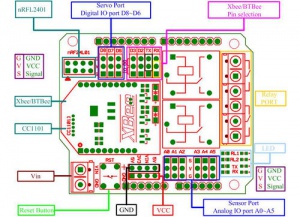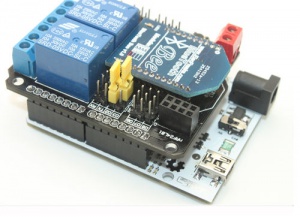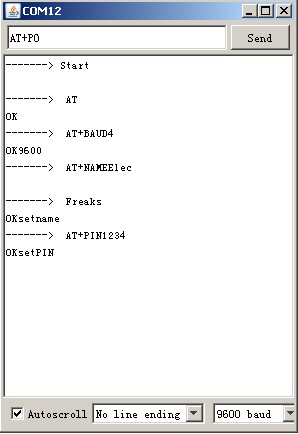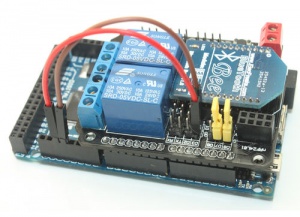Wireless Relay Arduino Shield
Pin definition and Rating
Programming
Use with Nrf24l01
The demo code is test the module RF, BTBee and Relay part. And the code base on the NRF24L01, you need change the pin define as below. If you test the Bluetooth Bee interface, you need used other Bluetooth device paired with BTBee. Here we used a Android phone with our APP as client to paired with BTbee(HC-o6), more about paired here.
#include "API.h"
//---------------------------------------------
#define TX_ADR_WIDTH 5
// 5 unsigned chars TX(RX) address width
#define TX_PLOAD_WIDTH 1
// 20 unsigned chars TX payload
//---------------------------------------------
#define CE 9
// CE_BIT: Digital Input Chip Enable Activates RX or TX mode
#define CSN 10
// CSN BIT: Digital Input SPI Chip Select
#define SCK 13
// SCK BIT: Digital Input SPI Clock
#define MOSI 11
// MOSI BIT: Digital Input SPI Slave Data Input
#define MISO 12
// MISO BIT: Digital Output SPI Slave Data Output, with tri-state option
#define IRQ 8
// IRQ BIT: Digital Output Maskable interrupt pin
//*********************************************
#endif
Control by Bluetooth Module Software Serial Port
- Use softserial library create software serial port, communicate with bluetooth module
#include <NewSoftSerial.h>
#include <TimerOne.h>
#define rxPin 2
#define txPin 3
NewSoftSerial mySerial(rxPin, txPin);
void Callback()
{
Serial.println("-------> Callback Send AT");
mySerial.print("AT");
}
void setup()
{
// define pin modes for tx, rx, led pins:
pinMode(rxPin, INPUT);
pinMode(txPin, OUTPUT);
mySerial.begin(9600);
Serial.begin(9600);
//Timer1.initialize(2000000); // setting callback is 2s
//Timer1.attachInterrupt(Callback);
Serial.println("-------> Start ");
}
void loop()
{
int i = 0;
char someChar[32] = {0};
// when characters arrive over the serial port...
if(Serial.available()) {
Serial.println();
Serial.print("-------> ");
do{
someChar[i++] = Serial.read(); // Note HC-06 end not '/r/n', direct input "AT" command from Serial port
}while (Serial.available() > 0);
mySerial.print(someChar);
Serial.println(someChar);
}
while(mySerial.available())
Serial.println((char)mySerial.read());
}
Arduino Mega or Hardware serial port
If you used Arduino Mage1280/250 there are some different.Please note the NewSoftSerial library about Mage2560 explanation in SoftwareSerial.cpp :
// Specifically for the Arduino Mega 2560 (or 1280 on the original Arduino Mega) // A majority of the pins are NOT PCINTs, SO BE WARNED (i.e. you cannot use them as receive pins) // Only pins available for RECEIVE (TRANSMIT can be on any pin): // (I've deliberately left out pin mapping to the Hardware USARTs - seems senseless to me) // Pins: 10, 11, 12, 13, 50, 51, 52, 53, 62, 63, 64, 65, 66, 67, 68, 69
That's mean the library do not support D0-D7 as receive pins, just could use pins:10, 11, 12, 13, 50, 51, 52, 53, 62, 63, 64, 65, 66, 67, 68, 69 for receive. So there are two way to resolve it, but all need external jumper wires.
- First method: Change the define of rxPin and txPin. Jumper wires connect DOUT-D10, DIN-D11.
#define rxPin 10 #define txPin 11
- Second method: Use the others Hardware Serialport because of Mage there are 4 hardware serialport. Jumper wires connect DOUT-RX1(D19) DIN-TX1(D18)
void setup()
{
Serial.begin(9600);
Serial1.begin(9600);
}
void loop()
{
int i = 0;
char someChar[32] = {0};
// when characters arrive over the serial port...
if(Serial.available()) {
Serial.print("-------> ");
do{
someChar[i++] = Serial.read();
}while (Serial.available() > 0);
Serial1.println(someChar);
Serial.println(someChar);
}
while(Serial1.available())
Serial.print((char)Serial1.read());
}



